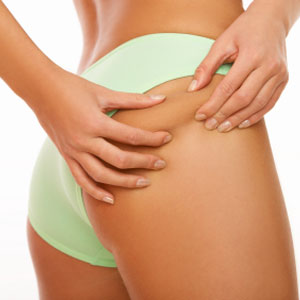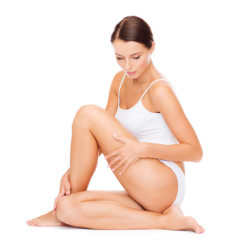The get rid of cellulite BIG misconceptions and misleading information…
A topic specifically for women so you want the correct information regarding cellulite, right?
Yes, this is a touchy subject for some women and there’s a lot to be said on this topic, especially if you suffer from unsightly appearance of cellulite…
Dear Friend,
Yeah, I’m sure even seeing that word makes you cringe a little…
Don’t fret because the truth is that about 80%-90% of post-pubertal females suffer from some form of cellulite.
Whether it is located in the thighs, pelvic region, buttocks, abdomen, or arms.
Think about women you see at the gym on a regular basis which never wear shorts but always opt for pants instead.
It’s not just you…
Some women would describe cellulite as visual and visceral betrayal of their aesthetics and self-esteem.
Cellulite gives a dimply, orange peel or cottage cheese appearance to the skin of thighs, pelvic region, buttocks, abdomen or arms in women.
Cellulite is not a disease, basically cellulite is a cosmetic alteration of skin which can take the form of unsightly smaller dimples or larger areas that form lumpy skin, deep dimples or creases.
The outermost layer of the skin you can see and touch is called the epidermis.
Directly under that layer is the dermis, which is where hair follicles, sweat glands, blood vessels, nerve receptors, and connective tissue reside.
Below the dermis is where you find subcutaneous fat or fat beneath the skin, which is also just above your muscles.

Under the dermis is where you find the origin of cellulite…
The skin dimpling you see on outside layers, the epidermis is caused by fat protrusions seeping into the dermis.
So how is cellulite caused?
Regardless of the individual, genetics play a huge role in whether or not you will be predisposed to cellulite.
Other genetic traits like having thinner skin or lighter complexion can also allow cellulite to become more visible.
Women have different connective tissue structure at the first layer of subcutaneous fat.
Cellulite affects women of all shapes, sizes and color including thin women too.
Caucasian females tend to be affected the most followed by Asian females…
Cellulite is present in females of all races.
In a study by Rossi and Vergnanini in 2000, shows high-stress lifestyle contributes to the accumulation of cellulite.
Best to find ways to distress if you’re always on edge or suffering from some form of anxiety.
Get an interesting book to read, massage or even play some music while you clean the house if that flips your skirt.
Exercise is also a fantastic solution but we’ll talk about the benefits of that in a moment…
Focus on what you can do, because there are some factors about cellulite you can control and others you cannot.
Inevitable circumstances such as aging tend to wear down the thickness and structural integrity of the skin.
This could heighten the appearance of cellulite.
Hormonal changes during pregnancy are also unavoidable…
Women generally have a higher percentage of body fat than men, particularly in the thighs, buttocks and hips.
These areas have five times more fat cells than any other area of their body, which is why cellulite is typically found.
The factors you can control is to avoid very low calorie diets or yo-yo dieting.
And chronically consuming excessively high intakes of carbohydrates, substantial increases in body fat, becoming sedentary and not drinking adequate amounts of fluids.
These factors may make the appearance of cellulite worse, seems kind of obvious right?
Is there a magical fix for cellulite?
Spending money on liposuction, subcision, injectables, skin kneading and manipulation techniques, laser treatment, thermotherapy, topical ointments and herbals for cellulite management may provide temporary relief.

Evidence for the long term effectiveness is limited and also very costly…
Some of these practices do more harm than good with risks ranging from permanent scarring, bruising, burns, skin deformation, painful knots, and in some cases the cellulite actually returns.
Your best strategy to combat cellulite is to choose a healthy lifestyle which combines nutritional plan with proteins, carbs and fats your body needs.
And regular exercise in the form of strength training and aerobic activity.
Studies confirm females that lose weight lessen the appearance of cellulite.
Make sure your intake of calories allows for steady fat loss without starving yourselves. Why?
Because crash dieting or other aggressive approaches can lead to rapid weight loss causing skin to thin out and sag, possibly making the appearance of cellulite much worse.
Along with the health-boosting benefits of regular exercise, utilizing regular resistance training helps shrink those fat cells leading to reductions in your total body fat percentage.
And increase strength, boosts confidence and provides more muscle definition in areas you want it most such as thighs, glutes, abdomen and arms.
Remember nutrition is going to be the most important factor in weight loss, so do regular exercises like squats and lunge variations to help tighten up your thighs.

Doing hip-thrusts and glute bridge variations give you a great set of glutes to fill out your favorite pair of jeans.
Reducing the appearance of cellulite around the midsection can be accomplished with various forms of direct abdominal exercise or core work while also dropping inches.
If you think you may have areas plagued by cellulite then I would recommend adding those exercises to your routines as solid examples.
Remember to manipulate loads used for each exercise in a progressive manner along with amount of sets, amount of repetitions and how frequently you perform each exercise week to week to ensure steady progress.
So you can get rid of cellulite…
References:
Avram, M. (2004). Cellulite: a review of its physiology and treatment. Journal of Cosmetic and Laser Therapy, 6, 181-185.
Emanuele E, Bertona M, Geroldi D (2010). “A multilocus candidate approach identifies ACE and HIF1A as susceptibility genes for cellulite”. Journal of the European Academy of Dermatology and Venereology 24 (8): 930–5.
Heyward, V.H. (2006). Advanced Fitness Assessment and Exercise Prescription 6th Edition. Human Kinetics.
del Pino, E., Rosado, R., Auela, A., Guzman, G., Arguelles, D., Rodriguez, C., and Rosado, G. M. (2006). Effect of controlled volumetric tissue heating with radiofrequency on cellulite and the subcutaneous tissue of the buttocks and thighs. Journal of Drugs in Dermatology, 5(8), 709-717.
Rawlings, A. (2006). Cellulite and its treatment. International Journal of Cosmetic Science, 28, 175-190.
Rosenbaum, M., Prieto, V., Hellmer, J., Boschmann, M., Krueger, J., Leibel, R.L., and Ship, A.G. (1998). An exploratory investigation of the morphology and biochemistry of cellulite. Plastic and Reconstructive Surgery, 101, 1934-1939.
Rossi AB, Vergnanini AL (July 2000). “Cellulite: a review”. J Eur Acad Dermatol Venereol 14 (4): 251–62.
Sadick, N., and Magro, C. (2007). A study evaluating the safety and efficacy of the Velasmooth™ system in the treatment of cellulite. Journal of Cosmetic and Laser Therapy, 9, 15-20.
Wanner M, Avram M (April 2008). “An evidence-based assessment of treatments for cellulite”. J Drugs Dermatol7 (4): 341–5.
Can You Get Rid of Cellulite

